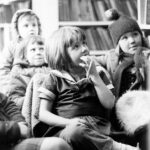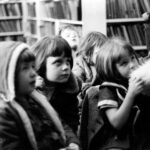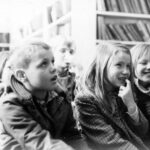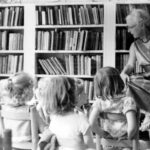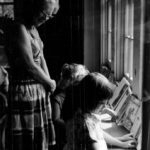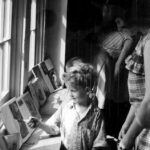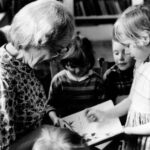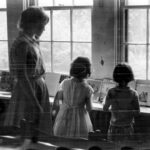Pine Mountain Settlement School
Series : PHOTOGRAPHS
090 LIFE AND WORK School Library Storytelling
Single Photographs Part I
090 LIFE AND WORK School (LWS) Library Storytelling single photographs Part I
TAGS: storytelling, Community School, storytellers, libraries, librarians, children’s libraries, books, oral traditions, community libraries, Mary Rogers, Rebecca Caudill Ayers, Judy Hensley, Richard Chase, Leonard Roberts. Teresa Osborne, Percy MacKaye, John Fiddler, Abner Boggs, John Shell, Katherine Pettit, Ethel de Long Zande, Ursula Le Guin, oral history
LIBRARIES AND STORYTELLING

STORYTELLING
… takes place in a time and place set apart: cyclic time, ritual time, or sacred time. Cyclical time is heartbeat body-cycle time; lunar seasonal, annual time: recurrent time, musical time, dancing time, rhythmic time….. A story is told again and again, and yet each new telling is a new event….
The living tongue that tells the word, the living ear that hears it, bind and bond us in the communion we long for in the silence of our inner solitude.”
Ursula K. Le Guin. The Wave in the Mind, 2004. p. 201, 205.
Photo: Paul Lynn. Storyteller Mary Rogers with children of the Community School at Pine Mountain Settlement.
MARY GOULD DAVIS
The following photographs are testimony to the magic of the spoken words of the story-teller. Mary Rogers, the Pine Mountain librarian was a wizard when it came to storytelling. Part of that wizardry was her British accent that captivated her audiences. Or, perhaps it was the inspiration of Mary Gould Davis, one of the Nation’s leaders in children’s storytelling. Davis was one of the founders of the Pine Mountain Settlement School children’s library.

Mary Gould Davis. The donor of funds for first PMSS Children’s Library. Boys House. Archive/Library room. Plaque and photograph in the Library (Boy’s House) Archive room.
Mary Gould Davis was a native Kentuckian and became a major figure in the campaign for children’s literacy. In her correspondence with Francis Hutchins, President of Berea College and a member of the Board of Trustees at Pine Mountain, she learned about Pine Mountain Settlement School and became a loyal supporter of the library and of the School. She was for many years the assistant librarian at Brooklyn Public Library and then moved to New York Public Library (NYPL) where she worked as an assistant librarian and honed her storytelling skills. She was soon advanced to children’s librarian and from there she found her way to Columbia University Library School where, in the 1920s, she taught Storytelling and courses in Children’s Literature and also wrote children’s stories.
In the 1940s, 1950s and 1960s visiting authors such as Rebecca Caudill Ayers, Leonard Roberts, Richard Chase, came regularly to the School and also left their literary gems with the enraptured children. Leonard Roberts and his family, and Richard Chase lived at the School for a time in the early 1940s. In fact, storytellers abounded at the School. Today storytellers such as Octavia Sexton and a myriad of other spinners of tales continue to offer fresh interpretations of older stories and many new ones that rely on both the Appalachian repertoire and language. Even folks not known as “storytellers” at the School and in the surrounding community knew how to “embellish” their tales and, regardless of status, if it was a good tale it was quickly circulated. Sometimes flannel-boards or puppets came with the story-tellers, but the tale and the tellers, with or without props, with or without storyteller credentials, rarely failed to capture the imagination of their young and old audiences and to encourage the art of further “embellishment” in the students and community.
EARLY STORYTELLERS
Katherine Pettit and Ethel de Long Zande, founders of Pine Mountain Settlement had their own repertoire of stories — some collected from local storytellers, and some they pushed forward from their own experiences. The list of Pine Mountain Settlement storytellers is, in fact, lengthy and goes back to its beginning. One need only assemble the letters home of many of the workers to find rich stories that capture the reader and most likely the “storyteller” who relayed the stories again to relatives and friends at home.
Though the names of some of the visiting storytellers at the School are nationally well-known, the Pine Mountain valley was a repository of storytellers whose names were locally well-known. Abner Boggs, John Shell, John Fiddler, Aunt Louize, Aunt Sal, and so many others all had reputations as storytellers. Appalachia has given birth to a community of aural learners and storytellers and the tradition carried through into many families. Surrounded by preachers, garrulous relatives, “preachy” aunts and uncles, and ballad singers, the models for children were many. Alice Cobb, a staff at the School in the 1930s and 1940s was a collector of stories and a generator of her own tales. She captured the essence of many of the local storytellers in her doctoral dissertation and in a large collection of stories now in the Archive at Pine Mountain Settlement and that may be found in Alice Cobb Guide to Writing, Stories ….
The language of the Appalachian native is rich and deep in history and has caught the attention of linguists around the world for over a century. Katherine Pettit was fascinated with the language of the Pine Mountain valley as were many other staff. Quotes, language and stories are sprinkled throughout letters, and notes, and comments found in the School Archive.
PERCY MACKAYE
Visitors such as the dramatist Percy MacKaye who spent the summer of 1921 at the School along with his wife in order to capture the stories and to be inspired by the language of the people for his plays. His most notable play about the region was “This Fine, Pretty World.” It spawned a series of plays focused on Appalachian tales that ran in New York’s theaters.
The May 1924 issue of Notes from the Pine Mountain Settlement School reported that four mountain plays by MacKaye “who spent a summer in our own valley,” were currently popular in New York City, including the popular “This Fine Pretty World.” The article in Notes is a response to readers who questioned the accuracy of MacKaye’s image of Kentucky and who feared a possible negative impact on the School:
“SO much has been written about the mountains this winter, in verse and fiction and drama and short articles, that we have wondered if people are not beginning to tire of us a bit. An echo of this is heard in the remark of a New York dramatic critic, who wrote for his paper this past season, “At last a play about Kentucky has been produced which is not laid in the Cumberlands and does not have for its plot moonshine and shootings.” This winter there have been four mountain plays all drawing full houses in New York. Sun Up has run since August, and is chiefly distinguished by the splendid interpretation of an old mountain woman given by Lucile LaVerne; The Shame Woman is by the same author. Of Hell-Bent Fer Heaven, one friend writes us that it is a splendid mountain play, while another, equally discriminating and well-informed, says it is “pure New York melodrama.” This Fine Pretty World was written by Percy MacKaye, who spent a summer in our own valley. [See Percy MacKaye for a full description of his work and that of his wife at Pine Mountain.]
JUDY HENSLEY
The most notable of which was More recently, scholars such as Loyal Jones, a master of storytelling, and Deborah Thompson*, Joan and Irene Moser, Artus Moser,* and Leonard Roberts, writer and former teacher at Pine Mountain Settlement, have all described the unique talents of the Appalachian storyteller. [*See: A Handbook to Appalachia: An Introduction to the Region, Grace Toney Edwards, JoAnn Aust Asbury, Ricky L. Cox, Univ. of Tennessee Press, 2006.]
Author and former Harlan County Schools teacher Judy Hensley is well known for gathering many of the tales of local storytellers both adults and children. When Judy retired in 2014 from Wallins Middle/Elementary School she left with a wealth of inspiration and material from her students whose deep well of spooky, inspiring, loving, and imaginative stories formed the basis of a number of books. So many ideas floated about in her classrooms about how to encourage storytelling in the schools and beyond and they continue to inspire other teachers. Publications on her list are legion and full of the facts and fictions of her students as well as her birthplace in Eastern Kentucky. She speaks to the larger world with her short stories, poems, and anthologies that reflect the best of storytelling in the region and the best in education.
Steve Flairity has called Judy Hensley one of his “Everyday Heroes” in his 2010 book, “Kentucky’s Everyday Heroes #2.” And she is just so. The environmental work to save Big Black Mountain from surface mining was initiated by her students and continued by Judy and a legion of other children and adults. While their efforts could not save many areas of the mountain, she greatly increased the potential for saving key environmental refuges from mountain top removal and degradation of water resources. She is, indeed, an environmental heroine, and a talented one, at that. She also served for many years on the Pine Mountain Settlement School Board of Trustees and was an inspiration to many who worked with her on environmental and literary projects associated with the School. She still inspires as a storyteller, a writer, a photographer, and an encyclopedia of local knowledge. Her enthusiasm for a good tale has inspired generations of students who are now budding writers, artists, dreamers, and environmentalists.
TERESA OSBORNE
Another well-known Harlan County storyteller is Teresa Osborne. A librarian and keeper and gatherer of the oral history collection at Harlan’s Southeast Community College. Teresa specialized in collecting biographical sketches in the form of oral histories, as well as stories and history from Harlan County folk. The Appalachian Collection at Southeast Community College, which she manages now numbers over 700 taped interviews that contain a wealth of information on the County of Harlan as well as nearby.
For many years Teresa entertained visitors at Pine Mountain with her interpretations of common children’s stories such as Three Little Pigs— always with a twist. Stories she told from the Jack Tales of Richard Chase as well as Leonard Roberts were always lively and animated. She passed the talent along to her daughter who worked for many years in the Environmental Education program at Pine Mountain Settlement and her influence may be seen in the spontaneous “stories” generated by many children who were introduced to her animated and performance skills.
MARY ROGERS
Mary Rogers, wife of Burton Rogers the long-time Director of the Pine Mountain School, and other librarians at Pine Mountain were storytellers of a somewhat different sort. Mary, with her distinctly British accent, drew on literary classics as well as the literature of the local — often comparing and combining the two. She left an auditory imprint that still enjoys a primary place in the memory of those who were fortunate enough to sit through her many storytelling sessions. Whether reading from Mark Twain or from Richard Chase’s Jack Tales or Beatrix Potter’s Peter Rabbit with its beautiful illustrations held gently for all to enjoy — the storytelling in the library fulfilled both the teller and the audience. In addition to her aural skills as a storyteller, Mary’s large repertoire of pen and ink drawings also are visual “stories” of the region. Beautifully observed records of the children and their life at the School, commentaries on the environment, and closely observed botanicals may be found in her work.
PAUL LYNN, PHOTOGRAPHER
The storytelling sessions from the 1950s and 1960s captured in these photographs are a story in themselves. The photographs from the 1960s are most definitely the work of Paul Lynn, a staff worker and skilled photographer. An album gathered by the photographer resides in the Archive collections as Paul Lynn Photograph Album. Also, other photographs from the 1960s in the SIA collection may be attributed to Lynn throughout the SIA photographic material.
The photographer has given his permission to the Archive at Pine Mountain Settlement School to digitally reproduce these treasures for the broad community. The following is PART I of Series 090 VII LIFE WORK Library Storytelling.
GO TO: 090 LIFE AND WORK School (LWS) Library Storytelling Part II
GALLERY – LIBRARY STORYTELLING I (Click to enlarge images)
- 01a Mary Rogers, reading stories to children in the Library. [90_LW_school_library_s_001a]
- 01b Storyteller, Mary Rogers. 90_LW_school_library_s_001b
- 01c Storyteller, Mary Rogers. 90_LW_school_library_s_001c
- 01d Storyteller, Mary Rogers. 90_LW_school_library_s_001c
- 01e Storyteller, Mary Rogers. 90_LW_school_library_s_001e
- 01f Storyteller, Mary Rogers. 90_LW_school_library_s_001f
- 01g Storyteller, Mary Rogers. 90_LW_school_library_s_001g
- 01h Storyteller, Mary Rogers. W_school_library_s_001h
- 02a 90_LW_school_library_s_002a
- 03a 90_LW_school_library_s_003a
- 03b 90_LW_school_library_s_003b
- 03c 90_LW_school_library_s_003c
- 03d 90_LW_school_library_s_003d
- 03e 90_LW_school_library_s_003e
- 03f 90_LW_school_library_s_003f
- 03g 90_LW_school_library_s_003g
- 03h 90_LW_school_library_s_003h
- 04a Mary Rogers, storyteller. 90_LW_school_library_s_004a
- 04b Mary Rogers, storyteller 90_LW_school_library_s_004
- 04c Mary Rogers, storyteller 0_LW_school_library_s_004c
- 04d LW_school_library_s_004d
- 04e Mary Rogers, storyteller. PMSS library in Boys House. [90_LW_school_library_s_004e.jpg]
- 04f Mary Rogers, storyteller 90_LW_school_library_s_004f
- 05a 90_LW_school_library_s_005a
- 05b 90_LW_school_library_s_005b
- 05c 90_LW_school_library_s_005c
- 05d 90_LW_school_library_s_005d
- 05e 90_LW_school_library_s_005e
- 05f 90_LW_school_library_s_005f
- 05g 90_LW_school_library_s_005g
- 05h 90_LW_school_library_s_005h
- 06a Mary Rogers, storyteller 0_LW_school_library_s_006a
- 06b 90_LW_school_library_s_006b
- 06c 90_LW_school_library_s_006c
- 06d Mary Rogers, storyteller 90_LW_school_library_s_006d
- 06e Storyteller, Mary Rogers. 90_LW_school_library_s_006e
- 06f 90_LW_school_library_s_006f
- 06g 90_LW_school_library_s_006g
- 06h 90_LW_school_library_s_006h
SEE:
083 LWS LIFE AND WORK School Chapel
084 LWS LIFE AND WORK School Clubs and Handiwork I
085 LWS LIFE AND WORK School Clubs and Handiwork II
086 LWS LIFE AND WORK School Clubs and Handiwork II
087 LWS LIFE AND WORK School Dining Room
088 LWS LIFE AND WORK School Library single photographs
088 LIFE AND WORK School Library pages
089 LWS LIFE AND WORK School Library single photographs
089 LIFE AND WORK School Library pages
090 LWS LIFE AND WORK School Library Storytelling single photographs
090 LIFE AND WORK School Library Storytelling pages
091 LWS LIFE AND WORK School Library Storytelling II single photographs
091 LIFE AND WORK School Library Storytelling II pages
092 LWS LIFE AND WORK School Music
093 LWS LIFE AND WORK School Playground and Pool
094 LWS LIFE AND WORK School Playground and Pool
095 LWS LIFE AND WORK School Playground and Pool
MARY ROGERS Biography
MARY GOULD DAVIS Donor
SEE ALSO:
A Handbook to Appalachia: An Introduction to the Region. Edited by Radford University scholars Grace Toney Edwards, JoAnn Asbury, and Ricky Cox, Knoxville, TN: University of Tennessee Press, 2006.
The Appalachian Voice: Storytelling – https://appvoices.org/2006/10/01/2787/










